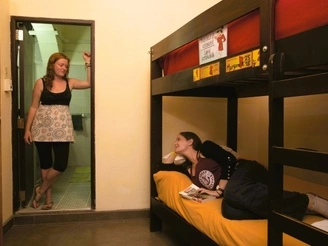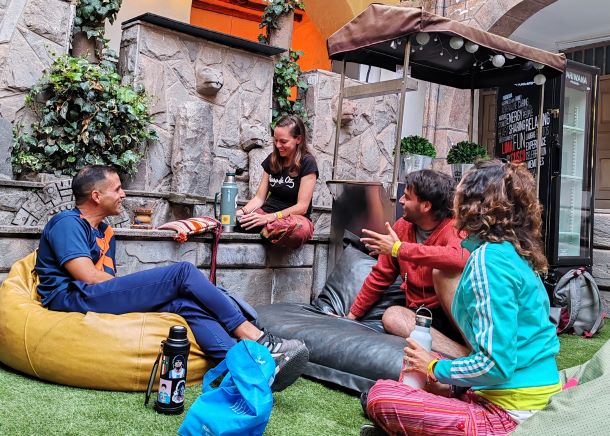Mixed vs. Female-Only Hostel Dorms: How to Choose and Why

Choosing between a mixed dorm and a female-only dorm can feel like a tiny detail—until your first night actually happens. Backpack on the bunk, new roommates, lights that may or may not go off, someone’s 5:30 a.m. alarm, the eternal whisper of zippers… That’s when you realize the dorm type matters. A lot.
This guide speaks backpacker-to-backpacker: honest, practical, and built to help you decide which dorm type fits you, when to choose it, and how to make the most of the hostel experience. Whether you’re traveling solo, as a couple, or with friends—whether your priority is price, safety, sleep, or a social vibe—here you’ll find a clear roadmap to choose well… and sleep better.
First things first: what’s what?
Mixed dorm
A shared room where travelers of any gender can stay. It’s usually the cheapest bed type at a hostel, with capacities from 4 up to 12 bunks (sometimes more). It’s the go-to option for those who want to meet people with zero filter: couples, groups, solo backpackers, digital nomads—the whole spectrum.
Female-only dorm
A shared room exclusively for women. It mirrors the mixed setup but is designed to offer extra privacy and calm to solo female travelers or groups of friends. In very backpacker-friendly cities—think Lima or Cusco—this option is increasingly common, often with 6 or 8 beds, depending on availability.
Private rooms (bonus track)
Not our main topic, but worth a shout. A private can save the day on key nights (before a flight, after a hard hike, or when your body begs for quiet). Pro tip: mixing privates with dorm nights often optimizes budget and sleep.
It’s not a binary choice—it’s situational
A frequent mistake is locking yourself into “team mixed” or “team female” for the whole trip. In reality, your best pick can change by city, itinerary stage, and energy level. Here’s a sane rule of thumb:
When landing in a new city (after a long flight or overnight bus): prioritize sleep and perceived safety → many women start with female-only.
Social streak (you want to go out, join plans, meet people): mixed tends to have more turnover and easier conversations.
Work/study phase (if you’re a nomad with deadlines): consider female-only or a small mixed (4–6 beds) to reduce noise.
Night before a demanding tour (Machu Picchu, Rainbow Mountain, Ausangate, Salkantay): aim for quiet and routine (shower, pack, lights out) → female-only or even a private for that critical night.
Pros and cons—no sugar-coating
Mixed dorm
Pros
Price: usually the lowest bed rate.
Social diversity: meet a wide range of travelers; perfect for finding last-minute buddies for tours or going out.
Availability: more beds in mixed dorms, handy in high season.
Cons
Noise & movement: more turnover = more late/early comings and goings.
Different living styles: cleanliness, order, bedtime rituals can vary widely.
Safety perception: it can take a night or two to feel fully at ease, especially early in your trip.
Female-only dorm
Pros
Sense of safety: many travelers relax more, and that improves sleep.
Atmosphere: often a caring vibe (lights off, route tips, low-key courtesy).
Relative privacy: fewer night-time comings and goings on average.
Cons
Price: sometimes a touch pricier than mixed.
Limited beds: sell out in high season; book ahead.
Slightly narrower mix: if you want max variety, mixed offers more randomness.
Signs a mixed dorm suits you today
You want to maximize savings and adapt easily to noise/light.
You’re eager to meet people and hop into spontaneous plans.
You’re traveling in a mixed-gender group and want to stay together.
You arrive during the day, feel energized, and the city’s calling your name.
Signs a female-only dorm is better today
You’re tired, it’s your first time in the city or country, or you want a soft landing to get your bearings.
You’ll wake up very early for a tour and want to reduce interruptions.
You’re coming from back-to-back nights on buses/treks and need sleep recovery.
The “hostel factor” matters more than the label
Not all hostels are created equal. Hostel quality impacts your experience more than the “mixed” vs. “female-only” tag. Look for:
Safe, central location: for example, Miraflores in Lima is convenient and well-trafficked; you can walk to parks, the coastal path, and key spots. Pariwana Lima sits in the very heart of the district—a super practical base. See the property and location here: Pariwana Lima (Miraflores).
Clear policies & present staff: check house rules, wristbands, lockers, quiet hours, etc. (Boring—until good policy saves you drama.) See a real-life policy reference here: Pariwana Terms & Conditions.
Community culture: activities, a helpful blog, and an honest, backpacker-minded approach are great signs the place thinks like a traveler. Get to know the philosophy and team: About Us.
Real safety vs. the feeling of safety
We often decide based on feeling more than data. That’s not wrong: being at ease is part of travel health. A female-only dorm can give you that first-night peace you need to “land” in a city. Beyond dorm type, focus on:
Lockers (ideally sized for big packs). Bring your padlock. Many hostels include lockers in rooms and/or at reception; the golden rule is to use them for passport, money, and electronics.
24/7 reception or night staff: someone responsible around the clock.
Controlled access (wristband, keycard, code) and clear rules (no visitors, smoking areas, etc.).
Nearby services (pharmacy, ATM, tourist police). In Peru, the national police emergency number is 105—save it on your phone.
Local tip: In Lima, the Tourist Protection Network and Tourist Police support travelers with official channels and an app. Check government resources before you arrive and save the useful numbers.
What does your budget say? Real impact in USD/Soles
Every city and season shifts prices. Mixed dorms are typically the cheapest beds. Female-only may cost a little more (not always), and privates are a tier above. Focus on total value:
If a mixed dorm saves you $3–6 per night, over 10 nights that’s $30–60 to spend on a tour, local food, or transport.
If one female-only night improves sleep and you perform better on a trek or remote work, that investment pays back.
Mix it: 2–3 mixed nights for every 1 female-only night (or vice versa). Flexibility is your ally.
Mini budget simulator (illustrative only)
7-night Lima & Cusco plan.
4 nights mixed + 2 female-only + 1 private before an early tour.
Assume $4 difference mixed vs. female-only and $20 extra for the private.
Total extra for strategic sleep ≈ (2×$4) + $20 = $28.
For less than many airport transfers, you lock in two quality-sleep nights plus one pre-tour calm night.
Solo female travel? A quick decision guide
First night in a new city → female-only.
Feeling confident on day two → try a small mixed (4–6 beds).
New friends on the road → consider mixed if you want to share a room.
Early tour → switch back to female-only the night before.
Feeling vs. data: if a mixed dorm feels off (noise, weird vibes), switch. Your peace comes first.
Pariwana offers female-only dorms in Lima and Cusco—great for that “calm first night,” then move to mixed if you want more social energy. In Lima, check Pariwana Lima (Miraflores). In Cusco, see Pariwana Cusco (Historic Center).
Traveling as a couple?
Mixed is wallet-friendly. If you want more privacy, alternate: 2 mixed nights + 1 private night.
Female-only won’t work to sleep together, but it can help if one of you needs better sleep for a night (the other stays in mixed).
Couple etiquette: headphones, packing cubes, and respecting quiet hours (yes, even as a couple).
Traveling with friends?
If your group is mixed-gender, a mixed dorm is more likely to keep you all together.
For bigger groups, many hostels (including Pariwana) can manage entire-dorm bookings and special rates. With some planning, ask for group reservations to build a setup that fits you: Group Reservations.
Digital nomad mode?
Rhythm: if you work early, try female-only or a small mixed.
Infrastructure: ask about cowork areas, in-bunk outlets, solid Wi-Fi, and quiet-hour policies.
Sleep hygiene: earplugs + eye mask + white-noise app = winning combo.
Bounded social: join hostel activities (classes, games, dinners) but set limits when deadlines loom.
Dorm etiquette (saves you side-eye)
Pack/Unpack smart
Prep a small day bag at night. Skip noisy plastic bags at 2 a.m.Lights & alarms
Use your phone’s flashlight; kill alarms the moment you get up (yes, all of them).Cleanliness & smell
Daily showers, aired clothes, and keep food out if the hostel says so.Bed = personal space
Don’t sit on other people’s beds; be gentle with privacy curtains.Headphones always
For calls, music, and videos.Communicate
If something bugs you, ask nicely. Most people respond well to a polite request.
For a full etiquette checklist, this blog piece is handy: Hostel Etiquette: How to Be the Best Roommate.
Common myths (and what’s real)
“You never sleep in mixed dorms.”
Overstated. It depends on dorm size, design (curtains, outlets, lights), rules, and the traveler mix at your hostel. With clear policies and good staff, sleeping well is perfectly possible.
“Female-only is boring.”
Nope. It’s just as social, usually with a slightly calmer vibe. Great to rotate depending on your energy.
“If I’m solo, female-only is mandatory.”
It’s not mandatory; it’s a tool. Use it when it serves you. Many travelers switch between both to optimize budget and sleep.
“Hostels are only for party people.”
False. Hostel culture is broad: common areas, activities, tours, a shared kitchen, cowork nooks… The core is community and experiences (not only parties). If you want practical reasons to pick a hostel, read: Why Stay in a Hostel?.
Safety & peace-of-mind checklist (for everyone)
Solid padlock for lockers (TSA/combo works).
Hanging toiletry bag: shower and done—no clutter.
Sleeping bag liner (optional): adds comfort and hygiene.
Earplugs + eye mask: miracle combo.
Power bank: no outlet fights.
Digital copies of documents (available offline).
Offline maps (Mapy.cz, Google Maps).
Local emergencies at hand: in Peru, Police 105.
Tourist protection programs: save hotlines and locate tourist police stations.
How to read reviews with a “hostel-eye”
Reviews help, but they have traps. Zoom in on:
Worst reviews: are they recent? Is the issue fixed? One-off or a pattern?
Best reviews: do they mention specifics (staff, cleanliness, lockers, activities) or are they generic?
Hostel replies: fast, proactive responses often mean they solve things on the spot.
Seasonality: high season = more turnover; naturally more “noise” in reviews, not necessarily worse service.
Booking strategy (so you don’t get stuck)
Define your mix: e.g., first Lima night in female-only to settle in, then mixed if you feel social.
Pre-book female-only on long weekends, holidays, or high season (Cusco June–August, for example).
Stay flexible: if the only option is a 12-bed mixed but there’s a 6-bed mixed on other dates, consider shifting nights.
Ask at check-in about lower/upper bunks if you have a preference (back issues, vertigo, early wake-ups).
Policies: deposits, lockers, check-in/out, wristbands, alcohol rules, common areas—know them. A real example here: Terms & Conditions.
Plan B: if a key night overlaps with a city-wide party, consider a private or a smaller dorm.
What about the social scene?
The vibe isn’t decided by dorm type alone; common areas and activities matter more: rooftop/terrace, bar, classes, games, community dinners, tours. A hostel with an active program and host-minded staff makes it easy to meet people and feel supported on the road. Pariwana’s network pushes community culture in Lima and Cusco, with activities that bring travelers together. Swing by the blog for ideas: Pariwana Blog (EN).
Lima vs. Cusco: micro-contexts that nudge your choice
Lima (Miraflores, Barranco & beyond)
Big city, spread-out nightlife. If you arrive late, many women appreciate female-only for the first night.
Miraflores has parks, the clifftop path, tourist police, and all services nearby; great base camp. Pariwana Lima is right in central Miraflores, steps from essentials: Pariwana Lima (Miraflores).
Typical combo: 1 female-only night + 2–3 mixed nights while you explore and make plans.
Cusco
Altitude and early starts for tours. If you’ve got Machu Picchu or treks on the agenda, book female-only the night before to ensure sleep; then switch to mixed after to socialize.
The city makes sharing easy—taxis to ruins, local restaurants, small hikes. Mixed can speed up that post-trek friend match.
To get oriented and set your base, check Pariwana Cusco (Historic Center).
Signs of a “good dorm” (beyond the label)
Solid bunks that don’t squeak with every move.
Personal outlet & light (if available, big plus).
Curtains or visual separation (premium in some hostels).
Spacious locker (fits a big backpack).
Visible ventilation and cleanliness.
Rules posted on the door or visible at reception.
Problem-solving staff: bed changes, towels, tour questions.
Mini guide: pick the right bunk (no regrets)
Lower bunk: practical for early risers or heavy packs; no climbing.
Upper bunk: more privacy and fewer people walking past; great if you’re a light sleeper with mask + earplugs.
Away from the door: less light and hallway noise.
Near outlets: clutch if you need to charge work gear.
Avoid windows if the street is noisy (buses, bars).
Ask at check-in: many hostels assign beds, but with a good reason (early tour, vertigo, injury) they often help.
What to pack for smoother co-living (pro list)
Earplugs & eye mask (yes, again: night-savers).
Quick-dry towel.
Shower flip-flops.
Padlock (plus a small spare).
Packing cubes to reduce mess and noise.
Long charging cable (2 m) for far outlets.
Laundry bag and a few zip bags for organizing.
Hand sanitizer and wipes.
Sleeping bag liner if you’re extra sensitive.
Small tote for bathroom essentials (so you don’t do five trips).
Common mistakes… and how to dodge them
“I’ll book nothing. Full improv.”
Improvisation is part of the fun, but female-only dorms often sell out first. If you’re arriving late or it’s your first time in town, book at least the first night.“Alarms are someone else’s problem.”
Set vibration or a watch alarm; and if yours rings, turn it off—no five snoozes.“I’ll leave my stuff on the bed—everyone’s chill.”
Use lockers for valuables and keep things tidy. Mess breeds friction.“Mixed means nonstop party.”
Many hostels balance it with quiet hours and designated areas. Check the rules and use common spaces for socializing.“I hate my bed, but I’ll tough it out.”
Talk to reception. Sometimes a simple bed swap or room change saves your night.
FAQs — Quick-fire answers
Mixed big or small?
Small (4–6): calmer, good balance for sleep + social.
Big (10–12+): more social, cheaper, more movement.
Mixed for a first-timer solo woman?
Yes—if you feel comfortable. If unsure, start female-only and switch later.
Is female-only worth a bit extra?
If it brings peace of mind, absolutely. Sleep affects your energy and how you enjoy the city.
What about snoring?
Earplugs, white-noise app, and if it’s intense, ask reception—there might be a bed change.
Late-night cooking without disturbing?
Yes, in the kitchen. Avoid food in dorms if rules say so.
What about huge luggage?
Ask for XL lockers or use designated storage. Keep your bunk clear.
Is it weird to switch dorm types mid-stay?
Not at all. Switching is normal—choose what fits you each day.
Activities to meet people without relying on dorm type?
Yes. Check the hostel calendar: tours, games, communal dinners, classes. Pariwana posts ideas on their blog.
Real-life scenarios: 5 quick cases
Arriving in Lima at 11:30 p.m. after a long flight.
Book female-only for the first night. Next day, switch to mixed if you’re up for it and explore Miraflores.
Heading to Cusco for a 4-day trek.
Pre-trek: female-only for early lights-out.
Post-trek: mixed to celebrate and share stories.
You must work with morning calls.
Book small mixed or female-only and ask about cowork space.
Traveling with two friends and one female friend.
Mixed to stay together. If someone needs a solid night, switch to female-only or a private for a night.
High season and almost sold out.
Prioritize location and policies. If only a large mixed is left, choose a hostel with clear rules & present staff. Use earplugs + eye mask and organize your bunk for noise control.
How to use the hostel’s site & blog to your advantage
Inspiration & tips: articles on etiquette, budget, safety, and more. Browse the Pariwana Blog (EN), including Hostel Etiquette: How to Be the Best Roommate and Why Stay in a Hostel?.
Policies & FAQs: get clarity from Terms & Conditions.
Meet the team & vibe: peek at About Us.
Group bookings: coordinate via Group Reservations.
Where to sleep: in the capital, see Pariwana Lima. In the Andes, check Pariwana Cusco.
Actionable recap
New city, solo, or sleep priority → female-only.
Max social + budget → mixed (prefer small if you’re a light sleeper).
Alternate based on energy and route; nobody sticks to one team the whole trip.
Focus more on the hostel’s quality (location, staff, rules, lockers) than the dorm label—that’s the real experience upgrade.
Adjust as you go. If a dorm doesn’t work for you, switch. Listening to yourself is part of traveling well.
✍️ Pariwana Editorial Team
Practical travel tips written by backpackers, for backpackers.

Tips to socialize and make friends on the road while enjoying your backpacking adventures.


